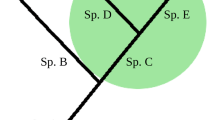Abstract
Ensemble theories have received a lot of interest recently as a means of explaining a lot of the detailed complexity observed in reality by a vastly simpler description “every possibility exists” and a selection principle (Anthropic Principle) “we only observe that which is consistent with our existence.” In this paper I show why, in an ensemble theory of the universe, we should be inhabiting one of the elements of that ensemble with least information content that satisfies the anthropic principle. This explains the effectiveness of aesthetic principles such as Occam’s razor in predicting usefulness of scientific theories. I also show, with a couple of reasonable assumptions about the phenomenon of consciousness, that the linear structure of quantum mechanics can be derived.
Similar content being viewed by others
References
E. P. Wigner,Symmetries and Reflections (MIT Press, Cambridge, 1967).
J. D. Barrow and F. J. Tipler,The Anthropic Cosmological Principle (Clarendon, Oxford, 1986).
Max Tegmark, “Is ‘the theory of everything’ merely the ultimate ensemble theory,“Ann. Phys. 270, 1–51 (1998).
Jürgen Schmidhuber, “A computer scientist’s view of life, the universe and everything,” In C. Freska, M. Jantzen, and R. Valk, eds.,Foundations of Computer Science: Potential-Theory-Cognition, volume 1337 ofLecture Notes in Computer Science, pp. 201–208 (Springer, Berlin, 1997).
Jürgen Schmidhuber, “Algorithmic theories of everything,” Technical Report IDSIA-20-00, IDSIA, Galleria 2, 6928 Manno (Lugano), Switzerland, 2000; arXiv:quant-ph/0011122.
Ming Li and Paul Vitányi,An Introduction to Kolmogorov Complexity and its Applications, 2nd edn. (Springer, New York, 1997).
J. Leslie,The End of the World (Routledge, London, 1996).
B. Carter, “The anthropic principle and its implications for biological evolution,”Phil. Trans. Roy. Soc. Lond.,A310, 347–363 (1983).
John Leslie,Universes (Routledge, New York, 1989).
Bruno Marchai, “Conscience et mécanisme,” Technical Report TR/IRIDIA/95, Brussels University, 1995.
Bruno Marchai, “Computation, consciousness and the quantum,”Teorie e modelli 6, 29–44 (2001).
Gunther Ludwig,Foundations of Quantum Mechanics I (Springer, Berlin, 1983).
Henry P. Stapp, “The basis problem in many-world theories,”Canadian J. Phys. 80, 1043–1052 (2002); arXiv:quantph/0110148.
Donald L. Cohn,Measure Theory (Birkhäuser, Boston, 1980).
Martin Bohner and Allan Peterson,Dynamic Equations on Time Scales (Birkhäuser, Boston, 2001).
Ramamurti Shankar,Principles of Quantum Mechanics (Plenum, New York, 1980).
Victor Stenger, “The comprehensible cosmos,” Draft book: http://spot.colorado.edu/~vstenger/nothing.html.
Steven Weinberg, “Testing quantum mechanics,”Ann. Phys. 194, 336–386 (1989).
Steven Weinberg,Dreams of a Final Theory (Pantheon, New-York, 1992).
Bryce de Witt and R. Neill Graham,The Many Worlds Interpretation of Quantum Mechanics (Princeton University Press, Princeton, 1973).
Author information
Authors and Affiliations
Corresponding author
Rights and permissions
About this article
Cite this article
Standish, R.K. Why Occam’S Razor. Found Phys Lett 17, 255–266 (2004). https://doi.org/10.1023/B:FOPL.0000032475.18334.0e
Received:
Revised:
Issue Date:
DOI: https://doi.org/10.1023/B:FOPL.0000032475.18334.0e




